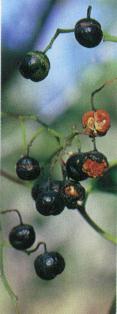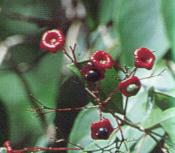|
The soft leaf
base is chewed to relieve pain of sore throat mouth and tongue. The white
leaf stem base is chopped, boiled in water, the liquid cooled and strained
then used as a wash or dropped into red or infected eyes. Leaves are used
extensively for fibre crafts such as baskets and mesh bags. Prop roots
are used as an external wash to treat scabies and very high fevers. The
wash must only be used once as it may irritate skin. The seeds (fruit
kernels) are eaten raw, being tasty and high in oil content. The soft
fleshy base of leaves is also eaten raw, containing carbohydrates. Good
walking tucker. The white cabbage is used to make a green dye and antiseptic
packing for wounds. The trunks are used to make didgeridoos and rafts

Leichhardt
tree
Nauclea orientalis
Coastal Aboriginal people in North Queensland use this tree. The trunk
wood is used for making toy canoes and paddles. Its fruit when crushed
with water is used as baby food, and is also used as a medicine for coughs,
colds, stomach pains and diarrhea. Towards the end of the dry the bark
can be used as a fish poison in small waterholes.
Photo: NT Conservation Commission


Cocky Apple
Planchonia careya
This is a very important tree to Aboriginal people around Townsville.
Calendar plant: tells people when it is time to fish barramundi by its
flowering time, also when turtles are fat and ready to eat. Leaves and
bark are used to treat boils, headaches, leprosy wounds, prickly heat
and chicken pox. Bark is crushed and thrown in waterholes to take oxygen
out of water and poison fish. Bark is also used to make belts and dilly
bags. Boomerangs are made out of the timber.
Photo: NT Conservation Commission

Beach Bean
Canavalia rosea
Good headache relief: the leaf is browned on the fire and placed over
the headache. It is used as a fish poison in salt water. The seeds are
edible after thorough cooking; otherwise they are poisonous when raw.
Photo - Society for Growing Australian Plants

Red Tea Tree, Red Paperbark
Melaleuca dealbata
This is a paperbark that tolerates salt water. With any paperbark you
can dig down to find fresh water. It has very strong wood that never rots,
with many uses for tools.
Photo - John Brock


Red ash
Alphitonia excelsa
The leaves of these trees are used as soap when crushed with water to
make a lather. The leaves and fruit are used as a fish poison in small
waterholes. Leaves, roots and bark are used for medicinal purposes: sore
eyes, upset stomach and headaches. Leaves are also used to wrap meat,
which is cooked in an open fire. The ash of the burnt timber can be mixed
with water to apply to ringworms and skin disorders.
Photo: NT Conservation Commission

Lolly Bush
Clerodendrum floribundum
This is an important plant for making firesticks. Local people would lay
the tree down to get straight firesticks from it. The stem is used for
making pipes. Straight stems are used for arm splints. Roots are like
parsnip to eat, but the fruit cannot be eaten. Young leaves can be crushed
and boiled in water; the liquid cooled and strained and used as a lotion
on scaly or itchy skin and sores. The lotion is also taken internally
to treat diarrhea, backache, internal pain, headaches, pains and bronchial
congestion. The left over liquid is applied to skin, left overnight and
washed off the next day.
Photo - Society for Growing Australian Plants

Sand paper fig
Ficus opposita
Scrapings of inner bark from the stem and the roots are boiled in water.
The liquid is cooled, strained and taken frequently in small doses. This
is an excellent remedy for diarrhea and is also used as an eyewash. Leaves
are crushed and soaked in water and the liquid is applied to itchy skin
conditions such as scabies and chicken pox. The rough sandpaper-like leaves
are used to rub onto skin infections such as ringworm prior to treating
the skin with other bush medicines. The fruit may be eaten when ripe (red
to brown). The leaves are used as sandpaper on wooden tools.
Photo: NT Conservation Commission

White Mangrove
Avicennia marina
Fruit can be eaten after extensive soaking and cooking. Leaves can be
used for flavouring food. Dry old timber is burnt and the black ash is
mixed with seawater to form a paste. This is applied daily to infected
sores, ringworm, boils and other skin disorders and is considered to be
a very effective treatment. Leaves and stems are used to relive marine
stings and bites. The timber is used to make shields and boomerangs.
Photo: NT Conservation Commission
|